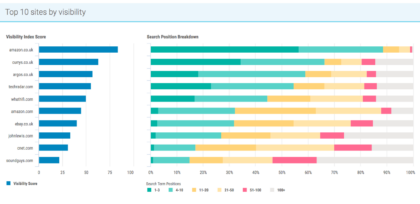How to boost visibility and please your online customers
24 Apr 2020|3 MIN READ
In this post we are going to examine why having a joined up internal linking strategy is an absolutely critical component of your SEO effort and the overall performance of your content. Internal links are vital for search engines, for everyone who produces content and of course they are essential for SEO.
https://www.youtube.com/watch?v=q_eVVd5q548&t=1726s
How important is internal linking?
Not only do well placed internal links contribute to a better experience for people who land on your pages, they help your customers find what they are looking for, and as well as that, they can help customers to discover related and relevant content that they may not have initially been looking for.
Links that are clearly labelled are a great navigational aid, providing, up-front, some understanding of what the destination page is all about. This results in higher click through rates as well as lower bounce rates.
Why is an internal linking strategy so important for search engines?
First and foremost, internal links are the primary mechanism by which Google finds and indexes your content. A coherent, crawl-able link architecture can make Google’s life a whole lot easier, while the opposite can make it very difficult for Google to crawl and index any of your content. It’s certainly not uncommon to find websites, even today that get migrated to ‘upgraded’ versions that are virtually impenetrable to search engine robots.
A coordinated and coherent approach to internal linking will help search engines to get a better understanding of your online offering and simply put, the better you get at making the right connections between all of your online assets, the better search engines will be able to visualise and understand your digital ecosystem.
Internal links, and in the case of body text links, help Google to understand and categorise a page before it even gets crawled. If these destination theme matching links are used consistently they act as powerful indicators as to what a page is about and how it relates to the pages it is linked from and to.
Why are internal links important for SEO and content teams?
If a page is added to a website without any internal links pointing to it, navigational or otherwise, it effectively becomes an orphan with little (not zero) chance of being crawled or indexed.
The right combination of navigational and contextually relevant body links on the other hand can provide a new piece of content with a significant boost of authority making it substantially more likely to perform well organically.
Every time that a new piece of content is about to be added, or even an old piece updated, one of the first questions that you need to ask is - ‘what other pages/pieces of content do I have on the site are contextually relevant?’ If you think that a body text link in particular from a contextually relevant page would benefit a customer then it will almost certainly be of benefit to Google.
These links will effectively channel authority and PageRank (Yes Google still uses this) to your new content.
One of the other questions you also need to ask at this time is - ‘do we have any content that might be potentially conflicting?’. This is covered in more detail in this article on contextual optimisation.
Do internal links help to improve search engine ranking?
The simple answer is yes. Anything that helps a search engine to get a better understanding of your online ecosystem and the relationship between all the assets in that ecosystem is overall, going to contribute to better visibility.
A more direct example is where internal linking is used, alongside theming to help fix content cannibalisation issues. In this example below, the organic visibility for this term dropped when new content on a topic was added to the ecosystem.
Because it was added in isolation and did not take into account existing, potentially conflicting content, nor did it leverage semantically related, complementary content, the result was a drop in visibility for the term.
In the period between the drop and the subsequent improvement in visibility, three pages were in conflict. This type of conflict is a common occurrence when Google is unsure of which page to return. By using the right anchor text between semantically related pages you can quickly help Google to get a better understanding of which page to return for which search term. In this case, there was a significant increase in organic visibility as well as traffic.

What is the ideal internal link structure?
The ideal internal link structure includes a combination of navigational links as well as body text links.
The navigational links in the diagram below are perhaps the primary way that Google and your searchers will navigate your content. These links are normally made up of a combination of a site navigation bar as well as breadcrumbs.
When a searcher lands on one of your pages it should be immediately obvious to them where they are in the hierarchy and how they can continue to navigate from here.

Navigational links play an important role in channeling authority. Category pages for example, because they are higher up in the hierarchy are generally (but not always) more authoritative and so links from these pages will channel authority to product pages.

Where the product name is used as anchor text, this will help the search engines as well as the searchers understand what the destination page is about.
In return, links from product pages back to category pages will be equally beneficial, if not essential for searchers as well as search engines.

These links will help search engines to understand what the category pages are and what they are themed for. Matching the anchor text to the theme of the destination page will be particularly beneficial. For example if the category page is themed for ‘smart watches’ then the anchor text should also be ‘smart watches’.
In addition to these navigational links, the addition of ‘horizontal’ body text links can be enormously beneficial to searchers as well as search engines.

For searchers they provide contextually relevant links for more information and the chance to discover something new and relevant. For search engines, these links help to channel authority and, where the anchor text matches the theme of the destination page, this helps search engines better understand the nature of the destination page as well as the relationship between pages and different entities on your website.
Used effectively, as part of acontextual optimisation process these horizontal links can help prevent internal cannibalization from happening in the first place.
Is it safe to use JavaScript links?
In a recent webinar discussion on internal linking with Dixon Jones, a guy who knows more about links than pretty much anyone else, Dixon mentioned that, contrary to popular opinion, Google now starts to index your Javascript within seconds of its initial HTML crawl of your site. You can read more on this in Dixon’s article on how Google handles JavaScript here.
In addition to that, Google has this excellent resource on JavaScript SEO basics. This accessible article discusses some best practices for improving JavaScript web apps for Google Search.
How to use internal links correctly
- Make it obvious where the link is going to take the user with contextually relevant, descriptive anchor text
- Be consistent with internal links. Try to match the theme (keyword(s)) of the destination page
- When adding new content, look for complimentary pages on your website and add links from these pages to your new content. (use the site: operator to help you find these older pages)
- Don’t overuse footer links. These can look spammy and they are likely to be less authoritative
- Don’t try to ‘sculpt’ PageRank/authority with a nofollow. This does not work.
- Keep your links natural and try to avoid over using multiple instances of the same anchor text on any one page. This looks unnatural and spammy.
Never miss a post
Join our mailing list and have our SEO news delivered straight to your inbox.
Never miss a post
Join our mailing list and have our SEO news delivered straight to your inbox.




